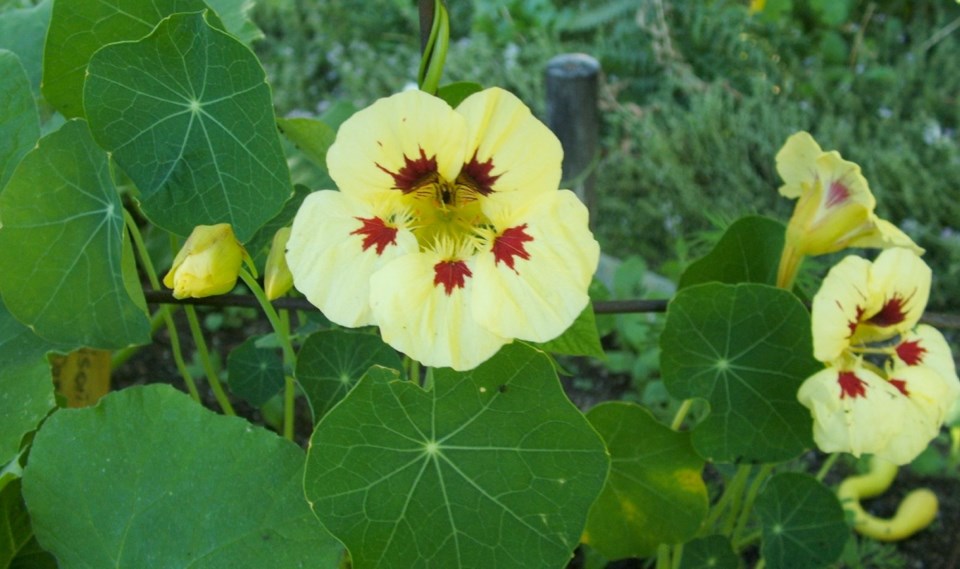A favourite flower from childhood is the nasturtium. I remember planting them with my father in the front yard of our Tattersall Drive home.
For lovers of this charming, cheery flower, there are many novelty forms to enjoy. One beauty that has done well for me is ‘Cream Purple Spot’ from T&T Seeds. The plants are compact and bushy, the flowers pale cream with a splash of purple at the base of each petal. The catalogue identifies this variety as a customer favourite.
A comparable nasturtium is ‘Cream Troika’ (Stokes Seeds) in creamy yellow with maroon markings. Variegated foliage is a distinct feature of this lovely variety. Veseys Seeds lists another similarly marked nasturtium, also creamy yellow but with “paintbrush-like” splashes of red. This one is called ‘Orchid Cream’. The plant habit is mounding.
New this year in the Veseys catalogue is ‘Orchid Flame’ — “A great partner for Orchid Cream” in “fiery red-yellow when the flowers first open, changing to a deep, dark burgundy when they mature.”
Each time I mention nasturtiums, I receive a barrage of mail from gardeners complaining their plants are ruined by black aphids. Others have written about keeping the plants and flowers pristine by growing them in the sun. One gardener deposits clumps of coffee grounds in the plantings to deter aphids.
I have found it helpful to plant small patches of nasturtium in different parts of the garden rather than to make just one or two more extensive plantings.
Irrepressible broccoli: I continue to view a planting of a baby broccoli (broccolini) called Aspabroc with keen interest and delight. There are six plants — seeded in late May and transplanted a month later.
From a late June transplanting, the plants would be expected to begin producing numerous small florets after 50 to 60 days, during the latter part of August. My plants developed nicely but stalled briefly during the hot weather, to begin producing prolifically with cooling early autumn temperatures.
I’ve been eating from those six plants ever since, with a brief lull during the cold, snowy weather around Christmas. Early in January, I peeked into the plants to find crowds of young florets emerging.
Aspabroc is not described as a “winter” vegetable but, like most cabbage-family vegetables, it is often at its best in cool conditions. This month’s florets with their crunchy stems are the sweetest, most tender yet.
Consider trying Aspabroc. Indoor seeding can begin in February for a March transplanting. Followup sowings made in early April and early June will yield a long season of tasty mini-broccoli florets.
Most seed catalogues list Aspabroc — West Coast Seeds, William Dam, Stokes.
Carrot tip: Adding to an ongoing conversation with readers about protecting carrot plantings from rust fly damage, G. Jackson wrote: “An hour ago (on Jan. 3), I pulled an enviable nine-inch carrot from the garden. As with all our carrots, it was perfect. I attribute the success to my seeding trick. Before sowing, I lay a thin, even layer of fresh coffee grounds in the furrow. That has always kept carrot flies away.”
Using coffee grounds might work to deter the flies where their populations are typically sparse. Where they are numerous, only insect netting or a floating row cover secured over a carrot-seed bed will ensure a crop of clean carrots.
The flies, drawn to the aroma of carrot foliage, lay eggs at the plant bases. Emerging larvae eat into the roots, disfiguring them with dark, rusty-looking tunnelling.
Garden events
Orchid meeting. The Victoria Orchid Society meets Jan. 22, at 7:30 p.m. in Gordon Head United Church Hall, 4201Tyndall Ave. Patrick van Adrichem will speak about cultivation of Phalaenopsis. Guests welcome.
View Royal meeting. View Royal Garden Club meets Jan. 24, at 7:30 p.m. at Wheeley Hall in Esquimalt, 500 Admirals Rd. Michael Fox will speak about a recent visit to Mosaic Canada 150, a giant horticultural exhibition of topiary figures depicting Canada’s history, in Gatineau, Quebec. As well, there will be a judged mini show and a sale of garden items. Visitors and new members are welcome.



